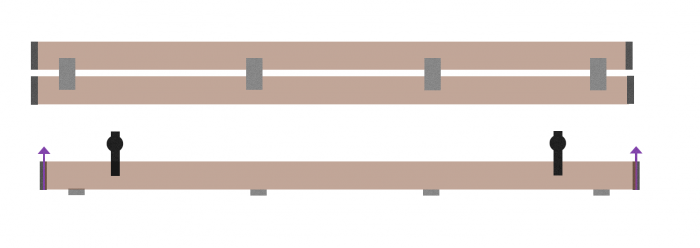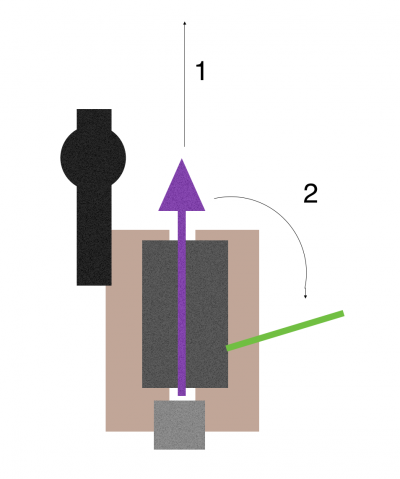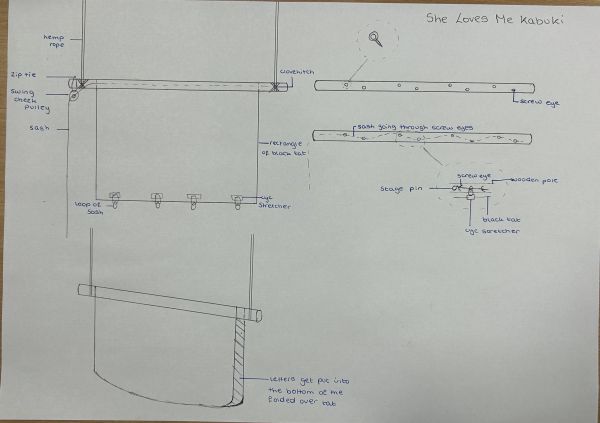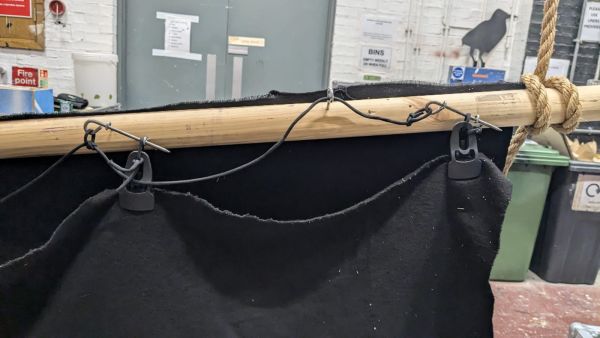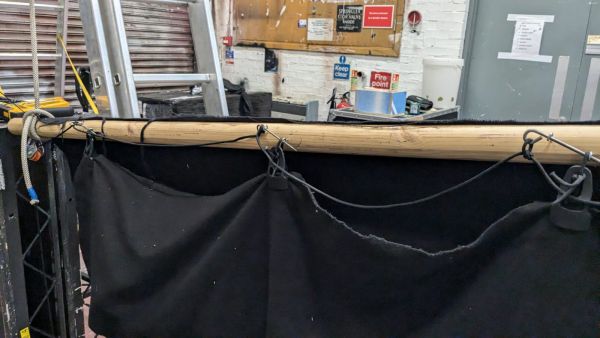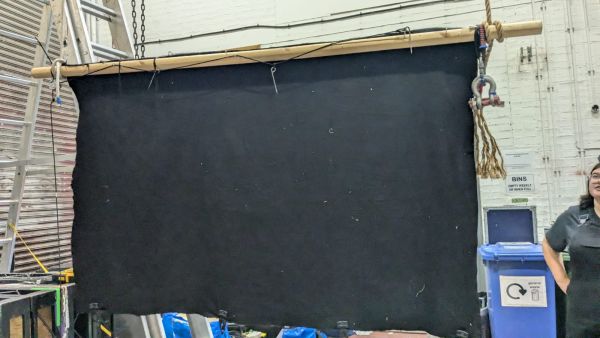Kabuki Drop
Eugene Onegin 2008
Effects – Kabuki drop from Eugene Onegin 08 by Callum Howie
The main stage effect in Eugene Onegin 08 is a kabuki drop, I will explain the effect and how we achieved it in the show, and I will also describe how to make one on the cheap.
Kabuki is the traditional style of Japanese theatre and the kabuki drop is the most common effect export from the style. The effect is when a flown cloth drops to the floor. As the cloth falls the air pressure on either side of the cloth causes it to fall straight down with small ripples in it. The effect is used to reveal the scene behind.
See this video www.youtube.com/watch?v=aIzHGg3lhOs
There are many different types of mechanisms to make the drop both mechanical and electronic which are available to buy or hire.
The kabuki drop used on Eugene Onegin 08 was an electromagnetic drop which is owned by Scottish Opera. The way this system works is a barrel with pins is attached to a standard flying bar. This barrel is loose and is able to spin; the barrel has two “arms” which are set inline with the pins. The arms have half of the electromagnet on it; it reaches to a platform which is fixed to the same flying bar. When in preset the arms are located to the platforms and the pins are pointing up. The ties are then able to sit securely. Again in the preset the magnets are attracted to each other with no current passing through the system, this is so that if there is a power failure the cloth will not drop.
When the system is fired the current pushes the magnets apart and the weight of the arms spins the barrel and makes the pins point downwards and the ties simply slip off.
The version of the drop we used in Eugene Onegin was altered slightly from a standard drop. Firstly the cloth was, by design, only half depth so the cloth had cord extensions to the ties from the cloth up to the bar. The cloth also had ties rather than eyes as well which it should have been for the way the Scottish Opera Kabuki drop works.
To make your own Kabuki Drop on the cheap is very simple.
- Get a wooden baton across the length of the drop.
- Lay out your cloth and mark on the baton where your ties are.
- place two screw eyes where each of your ties sit
- place a stage pin in between the two eyes
- Run a control line across the length of the baton also tie off to the end of the baton so the pins do not whip across the stage.
- From each pin tie up to the control line so that when you pull the control line all pins fall from the eyes.
- Tie your cloth to the pins.
The Seagull 2009
This project was undertaken by Kirsty Campbell for The Seagull which performed in the New Athenaeum Theatre November 2009
A kabuki drop is an effect used to achieve the sudden falling of an item such as a curtain, banner or fake body. Although there are various electric versions available at a price, it is also possible to make a simple manual Kabuki drop with the sort of hardware lying around on stage. For the recent production of the seagull we were required to design a mechanism which would allow six 4x8 meter soft black masking legs to drop to the ground at the same time. Below is a diagram of the chosen design, here is the video of the result.

Construction
For the main timber part of the design we chose to use CLS as this is thicker and sturdier than normal 20x70 timber. It is also less prone to warping and would give the masking a more even appearance, as well as being easier to drill repeatedly. Standard 55mm screw eyes were used along with thick loop pins to ensure that the weight of the masking wouldn't bend the pins and make them impossible to pull out. After some trial and error it was found that the best way to attach the masking leg to the Kabuki bar was with cable ties pulled through the cloth next to the ties at the top of the leg. This means that there is a connection which is less likely to get caught than the ties on the masking. To attach the kabuki bars to the flying bar we used barrel clamps.
Things to look out for
- It is extremely important to number the masking legs or other items in relation to the kabuki bars when more than one is being used, especially if the dropped items are being moved away from the area after the cue has taken place. Doing this will make the reset process much faster.
- If you do not want the string and pins to drop after the item has fallen, it is a good idea to tie the onstage end to the onstage end of the kabuki bar.
- If at any point items such as masking legs have to be moved whilst set in position make sure that they are pulled in a direction which will not cause them to drop e.g. if the string is being pulled from stage right, twist the leg towards stage left.
Inner Space 2016
Inner Space 2016 was a variety show done by PTM 1 in the New Athenaeum Theatre . The drop was designed by Yesha Subotincic West. It was built, rigged and operated by Amy Dawson, Dimitri Grant, Heather McKennan, Yesha Subotincic West and Reece Flynn.
Design and Construction
The design of the show and the lack of any budget required us to make a drop ourselves. It was also a great opportunity. The show was set lengthwise with the stage facing R1 and took up nearly all the available space with a square of hanging truss 6m up. For that reason we could not use a classic pin and screw eye kabuki because it must be pulled from an angle we could not get to. That being i the direction of the iron or the back wall. The design consisted of 2 wooden boards connected with back flap hinges. The front board had 17 angled nails pointing out toward the audience for the cloth to hang on. The ends of the boards they were kept folded up by 2 pin hinges. The drop was released by pulling the pin out with a hemp line run up to the grid and over to fly floor. Not shown in the diagrams below are 2 lines that run between the front and back boards with stopper knots to stop the board form falling past 90 degrees so that the cloth's fall was the same every time The cloth was a white gauze doubled over because of the size of the stage in relation to the size of the gauze. The ties were tied around loose cable ties to increase the slideyness of the cloth. It fell on to a leg laid out on the floor and was stuck by wrapping it up in the black and carrying it with 3 people from the front of the stage to the void.
Operation
The drop was operated by 2 people form the fly floor, one on each in rope and one person to simultaneously cue the operators so the pins were pulled out at the exact same time.
Click here to see a video of the test drop and the full size drop.
Cabaret 2016
Depending on how you count it there were 5 kabuki drops in Cabaret - The Musical, at 3 different point during the show. The first one was the curtain silk drop at the reveal of the Kit Kat Klub which was an electro kabuki borrowed from Scottish Opera. This article is about the other drops. The second one was 2 nazi banners that unrolled over the audience at the end of Act 1 during Tomorrow Belongs To Me. The catch was that this was that during intermission the flags needed to be struck which is what we used the second kabuki for. We had problems every time we used the kabukis. They did not work until opening night of the show.
Design
The final design consisted of 2 wooden boards, 1 for each banner. To see the general kind of drop used see The Seagull 2009 drop above.
On the backside facing the stage, there was a simple pin and screw eye kabuki with 2 pin points, one on each end of the board. Each pin (actually R-clip) ran through a mini delta attached through a grommet on the top of each end of the banner. On the front side was one pin and screw eye kabuki that held the banner in a roll with a loop of rope that ran through the R-clip. The middle of the banner was held taught by a length of climbing rope tied to a maillon and attached through a centre grommet. The drop at the front was released first, during the song by a cue from the DSM and the second drop was cued by the TSM during the intermission. The banners were lowered in on the climbing rope, and rolled and removed to the scene dock.



R-clip orientation.
Rigging
It was rigged with barrel clamps on a bar rigged on hemp above the pit extension technically"over the audience". The bar was flown on 2 hemp lines rigged from the LX bars in the catwalks and then dead hung from the bars using shackles and 1m strops. 2 cleats were temporarily attached in the gods and an in dead was set on the bottom cleat for the reset of the kabukis.
Operation
Click here to see the 2 banner drops
Important Checks
- We made sure to use R-clips on everything instead of normal pins and the R-clips sat in a very specific way (shown below). The R-clips sat in a way that they had 2 points of contact to keep the delta in and kept so that when pulled out the delta slid on the flat side of the clip.
- The bar was surged so that it didn't jerk too much when the first kabuki was released, possible dislodging the second kabuki.
- Ensured the middle lines were tied off to the correct tension or else the banner were folded at a funny angle in the air even though the second kabuki was still in.
Scavengers
As part of the design for Scavengers there was to be three polythene sheets hung in the upstage section of the Chandler. It was requested that during the transition between two scenes the polythene sheets would drop to the floor to be cleared by the cast as part of the scene change that was visible to the audience. It was discussed that a Kabuki drop would be used to create this desired effect and due to the budget constraints of the show it was decided that the drop was going to be a manual system instead of a power drop.
System
The system comprised of two 2m battens hinged together at the bottom using a backflap hinge. The back batted was fitted with two half coupler doughty claps that would allow the system to be rigged onto scaff and a whole in the centre of the batten for a safety bond. On the front batten a series of nails were hammered into the top of the batten with the heads of the nails removed. This would allow for the polythene sheets to be attached to the drop securely and allow for a smooth drop when the system was released. In the centre on the top there was a pin hinge that joined the two battens together with a line of cord attached to the pin as a control line that once pulled would allow the drop to release and open the front batten. There was also a small length of dynemma that kept the pin attached to the hinge meaning when fired the pin wouldn't travel far from the hinge, this also acted as a safety for the pin so that if the control line snapped the pin couldn't fall to the floor.
Operation
Three of the same systems were made, one for each sheet. Then each control line was fed through a series of pulleys to the SR gantry in the chandler where the system was fired. Each line was tied together at the same tension at the end meaning when you took tension and pulled the three lines the drops would fire simultaneously.
Images
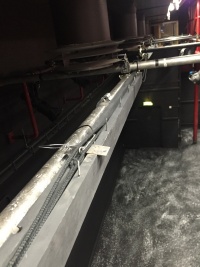
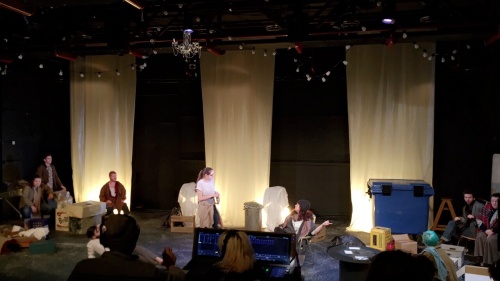
She Loves Me
Originally when we thought about how we would do a letter drop system, we decided on simply putting letters in two buckets that were zip tied to a pole with a pulley system, in order to tip the buckets over for the letters to fall out. However this turned out to not work well, as the buckets wouldn't fully tip enough for all the letters to fall out, and also all the letters clumped together instead of spreading and falling nicely. We went away and re thought our plan, and instead decided to create a simple old school kabuki style system.
We got a rectangular piece of black tat and found a wooden pole. We used the staple gun to attach one side of the black tat to the wooden pole, and on the other side we attached 4 cyc stretchers and bits of sash tied together in small loops. We then attached 4 pins evenly along one long piece of sash in order to create a release mechanism, making sure that there was enough sash to reach down to prompt side flys. Along the wooden pole, we put in 8 screw eyes for the pins to go through, in order to hold the other side of the tat up against the wooden pole. We made sure that the second screw eye of each group was at a lower height than the first, to make sure that none of the pins accidentally fell out and released the system at the wrong time. This all works by putting a pin through one screw eye, then through one of the sash loops, then through the second screw eye, and repeating this for each of the loops along the tat.
